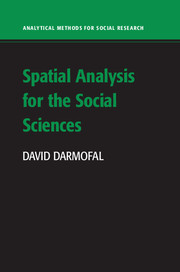8 - Time-Series Cross-Sectional and Panel Data Models
from PART II - ADVANCED TOPICS
Published online by Cambridge University Press: 05 November 2015
Summary
Thus far this book has examined diffusion processes from a cross-sectional perspective. Diffusion processes, however, are inherently temporal: behavior diffuses across spatial locations over time. As a consequence, cross-sectional evidence can only be said to be consistent with a diffusion process; it cannot definitively demonstrate that diffusion has occurred. To gain greater leverage in the diagnosis of spatial diffusion we ideally would wish to have observations arrayed over both space and time (see also Franzese and Hays 2007).
Social scientists are increasingly employing such space–time data in which multiple observations are available for each unit over several time periods. Examples include demographic datasets where researchers have data on the population makeup of the same countries for many different time periods or political science datasets where researchers have data on voter turnout for the same counties in many different elections.
As Beck (2001) notes, there is a critical distinction between two forms of space–time data, time-series cross-sectional (TSCS) data and panel data, even though the latter term is frequently used to refer to both types of data in econometrics. In the former, the units are fixed and of interest in themselves, and appeals to asymptotics involve the time dimension (T) (since the number of units in any given time period is fixed). In contrast, in panel data, the cross-sectional observations (N) strongly outnumber the number of time periods, which often are only two or three. True panel data in this sense typically take the form of survey sample data (and thus asymptotics can be based on N). Given this distinction, most spatial models of interest involve TSCS data as the spatial locations of survey respondents are typically not publicly provided due to confidentiality concerns in survey sample panel data. The focus of this chapter therefore is largely on TSCS data rather than on panel data.
- Type
- Chapter
- Information
- Spatial Analysis for the Social Sciences , pp. 141 - 157Publisher: Cambridge University PressPrint publication year: 2015
- 2
- Cited by

